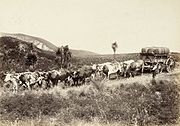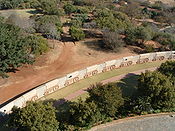
Ox-wagon
Encyclopedia



Ox
An ox , also known as a bullock in Australia, New Zealand and India, is a bovine trained as a draft animal. Oxen are commonly castrated adult male cattle; castration makes the animals more tractable...
en (draught cattle). It was a traditional form of transport
Transport
Transport or transportation is the movement of people, cattle, animals and goods from one location to another. Modes of transport include air, rail, road, water, cable, pipeline, and space. The field can be divided into infrastructure, vehicles, and operations...
, especially in Southern Africa
Southern Africa
Southern Africa is the southernmost region of the African continent, variably defined by geography or geopolitics. Within the region are numerous territories, including the Republic of South Africa ; nowadays, the simpler term South Africa is generally reserved for the country in English.-UN...
but also in New Zealand
New Zealand
New Zealand is an island country in the south-western Pacific Ocean comprising two main landmasses and numerous smaller islands. The country is situated some east of Australia across the Tasman Sea, and roughly south of the Pacific island nations of New Caledonia, Fiji, and Tonga...
and Australia
Australia
Australia , officially the Commonwealth of Australia, is a country in the Southern Hemisphere comprising the mainland of the Australian continent, the island of Tasmania, and numerous smaller islands in the Indian and Pacific Oceans. It is the world's sixth-largest country by total area...
. Ox-wagons were also used in the United States
United States
The United States of America is a federal constitutional republic comprising fifty states and a federal district...
. The first recorded use of an ox-wagon was around 1670, but they continue to be used in some areas up to modern times.
Design
Ox-wagons are typically drawn by teams of oxen, harnessed in pairs. This gave them a very wide turning circleTurning radius
The turning radius or turning circle of a vehicle is the size of the smallest circular turn that the vehicle is capable of making. The term turning radius is actually a misnomer, since the size of a circle is actually its diameter, not its radius. The less ambiguous term turning circle is preferred...
, the legacy of which are the broad, pleasant boulevards of cities such as Bulawayo
Bulawayo
Bulawayo is the second largest city in Zimbabwe after the capital Harare, with an estimated population in 2010 of 2,000,000. It is located in Matabeleland, 439 km southwest of Harare, and is now treated as a separate provincial area from Matabeleland...
, Zimbabwe
Zimbabwe
Zimbabwe is a landlocked country located in the southern part of the African continent, between the Zambezi and Limpopo rivers. It is bordered by South Africa to the south, Botswana to the southwest, Zambia and a tip of Namibia to the northwest and Mozambique to the east. Zimbabwe has three...
, which are 120 feet (36.6 m) wide, and Grahamstown
Grahamstown
Grahamstown is a city in the Eastern Cape Province of the Republic of South Africa and is the seat of the Makana municipality. The population of greater Grahamstown, as of 2003, was 124,758. The population of the surrounding areas, including the actual city was 41,799 of which 77.4% were black,...
, South Africa
South Africa
The Republic of South Africa is a country in southern Africa. Located at the southern tip of Africa, it is divided into nine provinces, with of coastline on the Atlantic and Indian oceans...
, which are "wide enough to turn an ox-wagon".
The wagon itself is made of various kinds of wood, with the rims of the wheels being covered with tyres of iron, and since the middle of the 19thc century the axles have also been made of iron. The back wheels are usually substantially larger than the front ones and rigidly connected to the tray of the vehicle. The front wheels are usually greater in diameter than the clearance under the tray of the vehicle so that the steering axle could not turn far under the tray. This makes little difference to the turning circle of the wagon because of the oxen drawing it (see above) and it makes the front of the wagon much more stable because the track
Axle track
The axle track in automobiles and other wheeled vehicles which have two or more wheels on an axle, is the distance between the centreline of two roadwheels on the same axle, each on the other side of the vehicle...
is never much less than the width of the tray. It also allowed a much more robust connection between the hauling trace
Trace (tack)
In transport, a trace is one of two, or more, straps, ropes or chains by which a carriage or wagon, or the like, is drawn by a harness horse or other draught animal. The once popular idiom: "kick over the traces" comes from a frisky animal kicking one or both feet outside a trace...
s of the oxen and the rear axle of the wagon (usually iron chain or rods) that is necessary for heavy haulage.
Most of the load-carrying area was covered in canvas supported by wooden arches; the driver sat in the open on a wooden chest (Afrikaans: wakis).
South Africa
The VoortrekkersVoortrekkers
The Voortrekkers were emigrants during the 1830s and 1840s who left the Cape Colony moving into the interior of what is now South Africa...
used the wagons during the Great Trek
Great Trek
The Great Trek was an eastward and north-eastward migration away from British control in the Cape Colony during the 1830s and 1840s by Boers . The migrants were descended from settlers from western mainland Europe, most notably from the Netherlands, northwest Germany and French Huguenots...
north and north-east from the Cape Colony
Cape Colony
The Cape Colony, part of modern South Africa, was established by the Dutch East India Company in 1652, with the founding of Cape Town. It was subsequently occupied by the British in 1795 when the Netherlands were occupied by revolutionary France, so that the French revolutionaries could not take...
in the 1830s and 1840s.
Often the wagons where employed as a mobile fortification called a laager, such as was the case at the Battle of Blood River
Battle of Blood River
The Battle of Blood River, so called due to the colour of water in the Ncome River turning red with blood, was fought between 470 Voortrekkers led by Andries Pretorius, and an estimated 10,000–15,000 Zulu attackers on the bank of the Ncome River on 16 December 1838, in what is today KwaZulu-Natal,...
.
After the discovery of gold in the Barberton
Barberton, Mpumalanga
Barberton is a town in the Mpumalanga province of South Africa, which has its origin in the 1880s gold rush in the region. It is situated in the De Kaap Valley and is fringed by the Mkhonjwa Mountains...
area in 1881, ox-wagons were used to bring in supplies from former Lourenço Marques
Maputo
Maputo, also known as Lourenço Marques, is the capital and largest city of Mozambique. It is known as the City of Acacias in reference to acacia trees commonly found along its avenues and the Pearl of the Indian Ocean. It was famous for the inscription "This is Portugal" on the walkway of its...
. James Percy FitzPatrick worked on those ox-wagons and described them in his famous 1907 book Jock of the Bushveld
Jock of the Bushveld
Jock of the Bushveld is a true story by South African author Sir James Percy Fitzpatrick. The book tells of Fitzpatrick's travels with his dog, Jock, a Staffordshire Bull Terrier, during the 1880s, when he worked as a storeman, prospector's assistant, journalist and ox-wagon transport-rider in the...
.

Afrikaner symbolism
In South AfricaSouth Africa
The Republic of South Africa is a country in southern Africa. Located at the southern tip of Africa, it is divided into nine provinces, with of coastline on the Atlantic and Indian oceans...
, the ox-wagon was adopted as an Afrikaner
Afrikaner
Afrikaners are an ethnic group in Southern Africa descended from almost equal numbers of Dutch, French and German settlers whose native tongue is Afrikaans: a Germanic language which derives primarily from 17th century Dutch, and a variety of other languages.-Related ethno-linguistic groups:The...
cultural icon. The ossewa is mentioned in the first verse of Die Stem
Die Stem van Suid-Afrika
Die Stem van Suid-Afrika was the national anthem of South Africa from 1957 to 1994, and shared national anthem status with Nkosi Sikelel' iAfrika until 1997, when a new hybrid anthem was adopted. It was also the anthem for South-West Africa under South African mandate until 1990.- Background :In...
, the Afrikaans
Afrikaans
Afrikaans is a West Germanic language, spoken natively in South Africa and Namibia. It is a daughter language of Dutch, originating in its 17th century dialects, collectively referred to as Cape Dutch .Afrikaans is a daughter language of Dutch; see , , , , , .Afrikaans was historically called Cape...
poem which became South Africa's national anthem from 1957 to 1994. When a pro-Nazi Afrikaner nationalist
Nationalism
Nationalism is a political ideology that involves a strong identification of a group of individuals with a political entity defined in national terms, i.e. a nation. In the 'modernist' image of the nation, it is nationalism that creates national identity. There are various definitions for what...
organisation formed in 1939, to oppose South Africa's entry into World War II
World War II
World War II, or the Second World War , was a global conflict lasting from 1939 to 1945, involving most of the world's nations—including all of the great powers—eventually forming two opposing military alliances: the Allies and the Axis...
on the British side, it called itself the Ossewabrandwag
Ossewabrandwag
The Ossewabrandwag was an anti-British and pro-German organization in South Africa during World War II, which opposed South African participation in the war...
(Ox-wagon Sentinel).
Australia

Teamster
A teamster, in modern American English, is a truck driver. The trade union named after them is the International Brotherhood of Teamsters , one of the largest unions in the United States....
s because they were cheaper, quieter, tougher and more easily maintained than horses therefore making them more popular for draught work. Frequently comprising long trains of bullocks, yoked in pairs, they were used for hauling drays, wagon or jinker loads of goods and lumber prior to the construction of railways and the formation of roads. In early days the flexible two-wheeled dray, with a centre pole and narrow 3 inches (8 cm) iron tyres was commonly used. The four-wheeled dray or box wagon came into use after about 1860 for loads of 6 to 8 tons and was drawn by 16 to 18 bullocks. A bullock team was led by a pair of well trained leaders who responded to verbal commands as they did not have reins or a bridle. The bullock team driver was called a bullocky
Bullocky
A bullocky is an Australian English term for the driver of a bullock team. Bullock drivers were also known as teamsters or carriers. The American term for a bullocky is a bullwhacker.-History:...
, bullock puncher or teamster
Teamster
A teamster, in modern American English, is a truck driver. The trade union named after them is the International Brotherhood of Teamsters , one of the largest unions in the United States....
.
Many Australian country towns owe their origin to the bullock teams, having grown from a store or shanty where teams rested or crossed a stream. These shanties were spaced at about 12 miles (19.3 km) intervals, which was the usual distance for a team to travel in a day.

